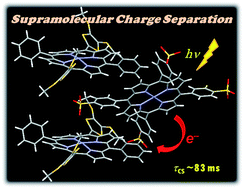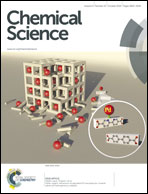Long-lived charge-separated states produced in supramolecular complexes between anionic and cationic porphyrins†
Abstract
A new supramolecular approach to generating a long-lived photoinduced charge separated state is described. It is predicated on the use of tetra-anionic sulfonated porphyrins (1-M4−: M = H2 and Zn) that form 1 : 2 supramolecular complexes with dicationic zinc(II) porphyrinato tetrathiafulvalenes (2-Zn2+) via strong electrostatic interactions. The X-ray crystal structure of the complex 1-Zn4−/(2-Zn2+)2 reveals a slipped sandwich-type interaction wherein 1-Zn4− is covered on both its top and bottom faces by two separate 2-Zn2+ porphyrins. Upon photoexcitation of the supramolecular ensemble, efficient photoinduced electron transfer from 1-M4− to the triplet excited state [2-Zn2+]* occurs to afford the triplet charge-separated (CS) states, as revealed by laser flash photolysis and EPR measurements. The CS state was found to decay via intramolecular back electron transfer within the supramolecular complex. This was evidenced by the observation that the CS state decay of this three-component system obeyed first-order kinetics and afforded the same long lifetimes irrespective of the initial concentrations of the CS state (e.g., 83 ms for the 1-H24−/(2-Zn2+)2 complex in benzonitrile at 298 K). Such an extremely long CS lifetime is thought to result from the spin-forbidden back electron transfer and the small electron coupling term, as inferred from temperature dependent studies of the CS lifetime. Decay of the CS state via intermolecular back electron transfer between two separate CS species of the type [1-M˙3−/(2-Zn˙+)(2-Zn2+)] is not observed, as revealed by the absence of second order decay kinetics. The absence of appreciable bimolecular decay processes and consequently the long-lived nature of the CS state is attributed to the central radical trianionic porphyrin (1-M˙3−) being protected from close-contact interactions with other species, precluding bimolecular decay processes. This supramolecular effect is thought to be the result of the radical species, 1-M˙3−, being sandwiched between two cationic porphyrins (2-Zn˙+ and 2-Zn2+). These latter cationic entities cover the top and bottom of the anionic species thus providing both a physical and electrostatic barrier to intermolecular deactivation processes. These conclusions are supported by solution state binding studies, as well as solid state single crystal X-ray diffraction analyses.


 Please wait while we load your content...
Please wait while we load your content...